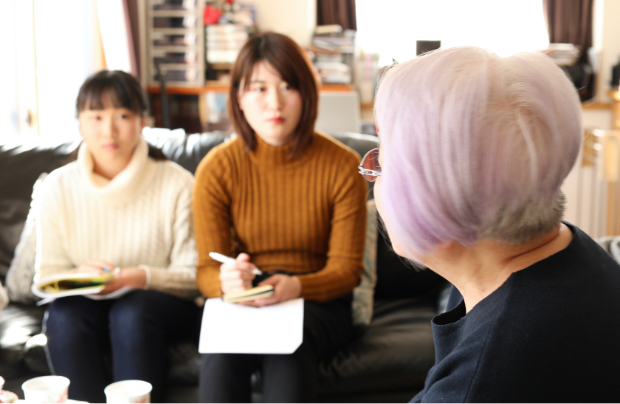HIROSHIMA memory keepers Succeed to history
Vol. 15 2019.6.15 up
I would like the children I am teaching to be people who can give other people an opportunity to get involved in peace activities.
Emi Imada
Hiroshima City elementary school teacher
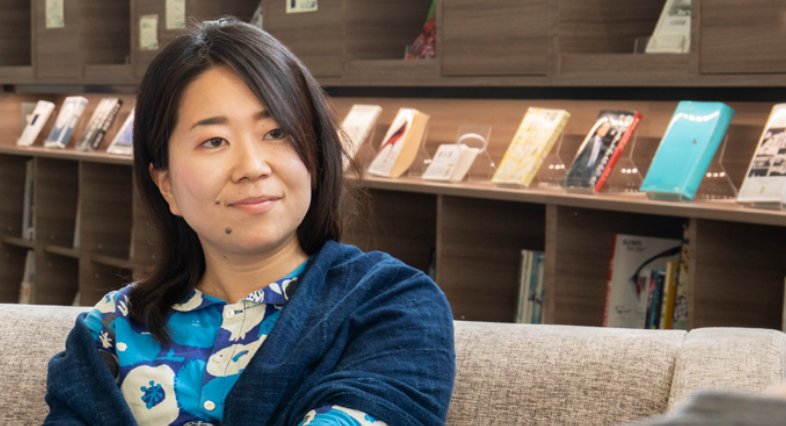
What do people handing down the experience of the A-bombing think and try to convey?
Emi Imada, 34, is an elementary school teacher in Hiroshima City.
She joined the Japan International Cooperation Agency (JICA,) and was dispatched to Egypt and worked there for two years.
We heard some anecdotes she had when she gave lectures overseas and about peace education programs in Hiroshima.
Section
The thoughts of the third-generation, whose grandmother was an A-bomb survivor

Today, Ms. Emi Imada joins us.
She is an elementary school teacher in Hiroshima City.
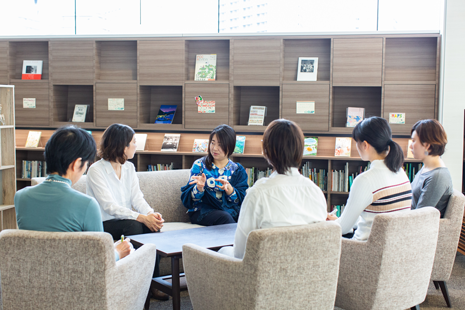
In February 2019, I met Ms. Imada in Egypt through one of my friends who also joined a JICA
program.
I had an opportunity to see the slides she made for the peace education program.
They were so nice that I wanted to hear more and I asked her for an interview.
Thank you.
I met you just before I came back after the JICA mission.
It was well-timed.
What do you do now?

When I met you, I was working in the JICA program.
Before I went to Egypt, I was an elementary school teacher in Hiroshima.
Where are you from?

I am from Hiroshima.
So, you have participated in peace education programs since childhood.
When did you have the thought leading to your present activities?

When I was in elementary school, I spoke as a representative of the student council in front
of all the students in our peace meeting.
In my speech, I used the words, “50 years after the A-bombing.”
At that time, even though I was an elementary school student, I had a sense of crisis, thinking that we would
have fewer people who have the experience of the A-bombing in the future.
My grandmother was a survivor and died when I was in kindergarten.
I thought that as she was a survivor, the A-bombing was also my problem.
Then, after I grew up, I wanted to convey what happened in Hiroshima at the time of the A-bombing.
I moved out of Hiroshima as a college student, and I was surprised there was no peace education program like
Hiroshima there.
Since coming back to Hiroshima as a teacher, I have made programs for children in which they can feel what
happened in the past, as if it had happened to themselves.
Have you ever heard your grandmother’s A-bomb experiences?
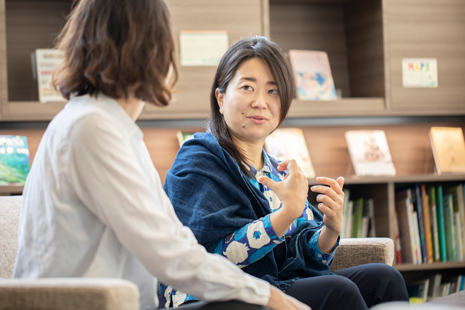
No, I haven’t. Because she was my grandmother, I was too close to ask her about her tragic experiences, so I hesitated.
When I was 28, long after her death, I heard about her experiences from my aunt.
According to my aunt, when the A-bomb was dropped, my grandmother was in the Hiroshima Clothing Depot in Minami
Ward.
She was not affected so much.
Then she moved to her relative’s house in Kita-Hiroshima-cho, and she was discriminated as “a child from
Hiroshima” there.
When I heard the story from my aunt, I thought that the first-generation wanted to forget about the A-bombing,
because they were scared. They just had to survive.
They didn’t want to talk about their experiences because they would be discriminated against. They could not
think of handing down their experiences to the next generation.
When I, the third-generation, was a child, it started to be said that we need to hand down the A-bombing
experience.
Many first-generation survivors didn’t want to talk about the A-bombing or remember it.
Participating in the memorial service in India
What made you want to learn about your grandmother’s experience?

I attended a memorial service for the A-bomb victims in India in 2013.
I joined the tour after reading about it in the newspaper.
I was surprised that the memorial service for A-bomb victims was held even in a foreign country.
Before the trip to India, I told the organizer that my grandmother was a survivor.
They asked me to talk about her experience, and I asked my aunt to tell me.
What was the memorial service in India like?
I visited Pala in Kerala, southern India, and New Delhi.
In a private school in southern India, they respect all religions, such as Hinduism, Christianity and Buddhism,
and held a memorial service for A-bomb victims beyond religion.
Students had learned very well about Hiroshima and Nagasaki, and they sang songs and recited
the verses from the Bible in the service. A lot of pictures and materials were displayed.
In New Delhi, there was an exhibition of original paintings of the animation, “Town of Evening Calm, Country of
Cherry Blossoms.” I gave a presentation about the A-bombing there.
After the presentation, I got cont-ttl-qs, such as, “Has Hiroshima been restored?” “What were
the radiation effects?” “I heard that your grandmother was discriminated against as a survivor. How about you as a
third-generation?”
I also had the cont-ttl-q which leads to the present problems, “Japan might continue to use nuclear power.
What do you think about that?”
You got a lot of cont-ttl-qs, didn’t you?
What you answer might sound like a representative of Hiroshima and Japan.
Wasn’t it hard to choose your words?

In my childhood, I thought that I might talk about the A-bombing some day as a representative of Hiroshima.
So, I tried to convey my messages clearly, although I said they were only my personal opinions.
The most impressive cont-ttl-q I had in India was from one high school student.
He said, “About 50,000 people are killed in traffic accidents in the US per year.
You said 140,000 people were killed in the A-bombing in Hiroshima by the end of 1945, which is just three times as
many as the number of traffic accident victims in the US.
Why have you been talking about what happened 70 years ago?”
What was your answer?
I told him not just to focus on the number.
I said, “What if your families and friends were included in the 140,000?” “Don’t forget that every one of them
had families and friends.” I asked him to use his imagination and think about it.
Also, talking about Sadako Sasaki, I told him that what is frightening about the A-bombing is that it doesn’t end at
that moment, but it has other problems, such as radiation effects and discrimination, which continue later on.
What I keep in mind when I have a presentation overseas
In how many countries have you given presentations?

I did presentations in Egypt, India and Cambodia.
Before visiting foreign countries, I study hard about the country’s history, religion and culture.
You have many slides. Do you make new materials for each country whenever you have a presentation?

Yes, I do, thinking about the country and the audience.
Do you speak in English?

I sometimes speak in English or Arabic.
But in most cases, I speak Japanese, because luckily, I had an interpreter each time.
When I made a speech in English, it would be sometimes difficult to make a delicate nuance understood.
I am very grateful that I have had interpreters who could make my messages clear.
In Egypt, I started my speech in Arabic and then I said, “Now, I will speak in Japanese,” which made everyone
laugh.
What do you have in mind when you construct your slide materials?
I give priority to getting sympathy from local people.
For example, as Egyptians care a great deal about their families, I talk about the stories of my grandmother and
family.
When I showed my grandmother’s picture, they were surprised that even though she was A-bombed, she survived.
I said, “Yes, she survived and her life was relayed to me.”
To people who don’t know what happened at the time of the A-bombing, I try to explain each of the real facts of
the A-bombing.
In Islamic countries, I give an explanation using the pictures drawn by the survivors, not the photos of
people’s exposed skin.
Do you have any response of the local people which impressed you in Egypt?
Unexpectedly, many people were interested in the fact that not only people but also trees were
affected by the A-bomb.
They said, “Even though they were A-bombed, they have maintained their lives to the next generation. That is
wonderful!”
It is interesting that you got sympathy through the A-bombed trees.
What kind of people came to your presentation?
About 50 Egyptians came, from their 20’s to 50’s, who were interested in Japan.
60% of them were women, and 40% were men.
I was surprised that there were more men than I had expected.
Now in Egypt, a school which has a Japanese education program has just opened and Egyptians respect the Japanese.
As to the peace education programs in Hiroshima
Many people outside Hiroshima don’t know about the peace education programs here.
Could you tell me about what they are?
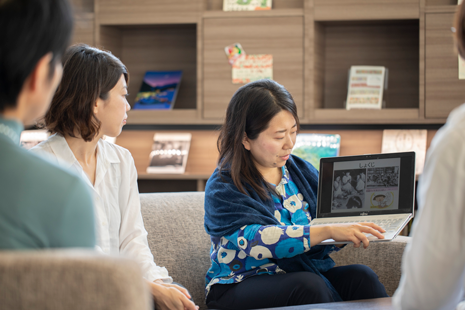
In many schools, from elementary to high school, in Hiroshima City, they make time for peace
education in the curriculum.
At schools where I taught, we had a peace seminar in summer vacation.
Before the meeting, students learn about the A-bombing and fold paper cranes.
Then, representatives of the school donate them in the meeting to Peace Memorial Park and other places.
We also use the “Peace Notebook” which was made by Hiroshima City.
Using that notebook, we have at least three hours of peace education a year.
When the notebook was made, I was in charge of peace education, and I got involved in making our school program.
What do you keep in mind when you talk about the A-bombing to elementary school children?
In elementary schools, we mainly try to appeal to children’s emotions by using animated movies.
I want them to learn what the lives of children as old as they are was like during wartime, and I focus on
housing, food and clothing.
For example, I told them that during the war, first and second graders stayed with their
families, while third to sixth graders were evacuated in groups to the countryside.
They grew potatoes and vegetables in the fields by themselves.
Now we can have balanced diet, but during the war, they ate just what they could harvest in the fields.
Under the rationing system, they could not buy what they liked.
Also, I talked about clothing.
People wore baggy work pants called monpe, civilian uniforms and air-raid hoods which had their address, name and
age in case of emergency.
I am sure that children would be more interested by comparing their lives at present with those children’s lives during the war.
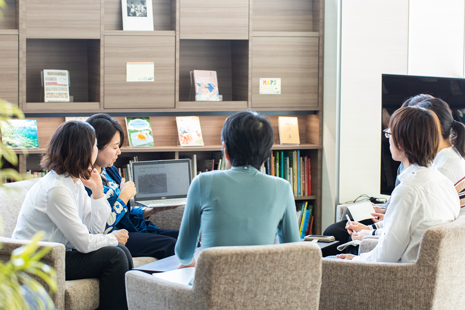
Yes. When I was at Ushita Elementary School, where I taught just before I left Japan, we used
war-damaged buildings and sites near the school for the program.
Although Ushita is a little far away from the hypocenter, many war-damaged places remain there.
We have the east drilling grounds and the place called the pika-don bamboo bush, which used to be a refuge but
doesn’t remain anymore.
We did field work, and each grade went to a different place.
In these materials, there is a picture of what we call “the patron saint in the cherry
riverbank” in Ushita.
It is said a father built this statue, thinking of his son who died in the A-bombing while he was working at a
building demolition site. Even today, people in the neighborhood take care of it. This story is introduced as a
picture book.
In this picture, the priest is talking about the A-bombing in Anrakuji Temple.
There is an A-bombed ginkgo tree in the precincts which still stands strongly.
The tree has a yellow plate, showing that it is an A-bombed tree.
Children can learn the meaning of the yellow plate and understand that there are many A-bombed trees in Hiroshima.
Through peace education programs, I would like to tell children that what we see now in our neighborhood is connected to the past, and local people are taking care to preserve it.
If we stop talking about what happened in the past, what kind of history we have in our neighborhood and how it has led to the present will be forgotten.

Yes. Ushita Park where children are playing now, used to be the place where A-bomb victims, whose families and
relatives had not come to claim them, were cremated.
There is a monument there, and a memorial service is held every year, but there are fewer people who know about
it.
Under the slogan, “First learn, keep learning, then hand it down,” I am making the materials for the
program.
Toward children in Hiroshima
As a teacher, what do you think of students’ attitudes toward peace education programs?

They support the programs and absorb them like a sponge.
When they grow up, they might have a chance to go abroad.
If they say they are from Hiroshima, someone might ask them about the A-bombing.
I would like them to talk about it with confidence, remembering what they learned in the peace education
programs.
I am sure there are many people who want to hear the stories told in their own words, not just the information
or data.
Hiroshima is training A-bomb Legacy Successors, aiming at handing down the survivors’ experiences to the next generation.

Meeting someone could make you start peace activities.
There are many people who offer opportunities where people can convey the A-bombing facts and think about war
and peace. I think it is precious to give a chance to meet new people, whatever the method it is.
I would like the children I am teaching to be people who can give other people an opportunity to get
involved in peace activities.
Thank you very much.
Interviewed on May 2019.
About
"Interviews with HIROSHIMA memory keepers" is a part of project that Hiroshima「」– 3rd Generation Exhibition: Succeeding to History
We have recorded interviews with A-bomb survivors, A-bomb Legacy Successors, and peace volunteers since 2015.
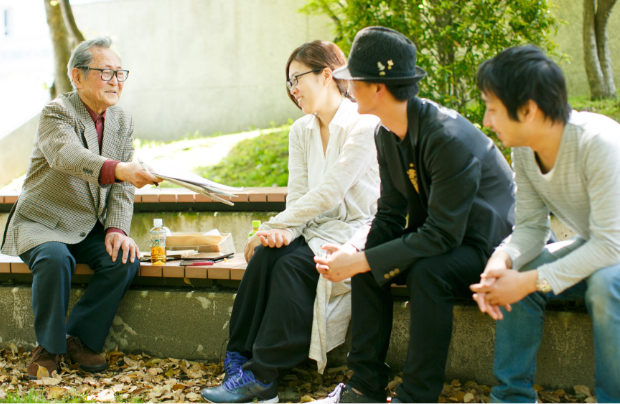
What are Hiroshima memory keepers feeling now, and what are they trying to pass on?
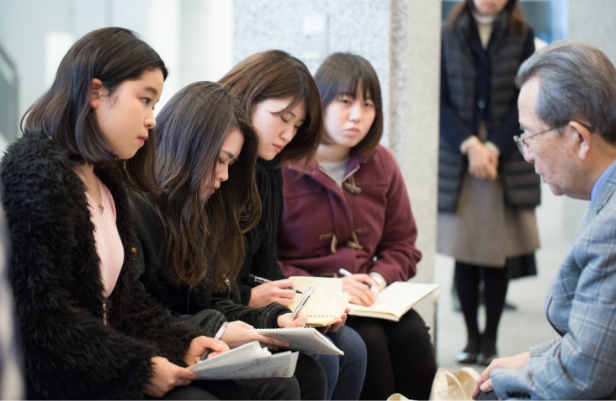
What can we learn from the bombing of Hiroshima? What messages can we convey to the next generation? Please share your ideas.
